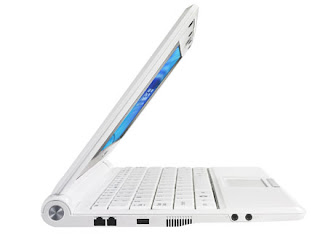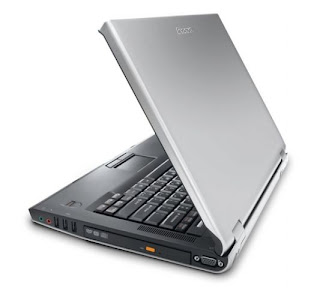The TravelMate 6592 is a desktop replacement model. The TravelMate 6592 is nominally a 'thin-and-light' laptop, but its relative bulk means it's functionally a desktop replacement. At 2.9kg you're unlikely to want to carry it very far or very often, and if you do make it a travel companion you'll need a pretty capacious bag. It plants a footprint 360mm wide by 275mm deep. At its maximum, the TM 6592 is 37mm thick.

This laptop's color scheme is no great surprise: it has a slate-gray lid section, and black innards with gray highlights that are slightly lifted from the humdrum by a few emerald-green accents.
A solid dual-action clasp keeps the lid and keyboard sections together when the laptop is not in use, and build quality is generally very good. The lid section, in particular, feels reassuringly solid. All this bodes well if you do choose to carry this laptop around.
The keyboard is distinctive because of the five-degree curve on which the keys rest. This places the outer keys nearer the screen than the inner ones, encouraging you to hold your wrists at a slightly wider angle than usual. Acer says this helps with user ergonomics, and we can confirm that this design does indeed feel more comfortable for touch typing than standard laptop keyboards.
The spread of keys is wide, with a row of two-thirds-height function keys sitting atop a row of full-sized number keys. When it comes to cursor movement, Acer offers two options. The touchpad has two enormous mouse buttons beneath it, with a central navigation pad for vertical and horizontal scrolling. Alternatively, there's an emerald-green mini joystick nestling between the G, H and B keys. A second pair of mouse buttons, with emerald green accents, sits above the touchpad for use with the pointing stick. The fingerprint sensor sits between this second pair of mouse buttons.
Above the keyboard there's space for four shortcut buttons. Two are preconfigured to launch Outlook Express for email and Internet Explorer for Web browsing. You can change these settings and also program a third personalized launcher button. The fourth button opens Acer's Empowering Technology utilities, a set of tools for managing things such as presentation mode settings, backup, security and password management.
For processing power, our TravelMate 6592 review sample had a 1.8GHz Intel Core 2 Duo T7100, backup by 1GB of RAM (expandable to 4GB). Wi-Fi (802.11a, b, g and n), Bluetooth (2.0+EDR), infrared, Gigabit Ethernet and a 56Kbps V.92 modem are all built in.
Graphics were handled by a discrete ATI Mobility Radeon X2300-HD module in our review sample, although other configurations are available. The hard drive, a 160GB unit spinning at 5,400rpm, can be downgraded to 80GB or 120GB if necessary. The optical drive sits in a modular bay that can also accommodate a second battery or a second hard drive.
Acer's Crystal Eye webcam, which sits above the screen. The camera captures stills and video at 640x480 and 320x240 pixels. The TravelMate 6592 is reasonably well kitted-out with ports and connectors. However, there are only three USB 2.0 ports, two side-by-side on the left edge, and one at the back on the right. The left-hand side also houses a FireWire (IEEE 1394) port, an ExpressCard/54 slot, a PC Card slot, a SmartCard reader and a flash card reader that accepts SD, MMC, Memory Stick and xD media.

At the back, you'll find S-Video, DVI-D, VGA and serial ports, along with modem (RJ-11) and Ethernet (RJ-45) connectors and the power jack. The front houses microphone, headphone and line-out jacks and the infrared port. There are also two mechanical slider buttons here: one toggles Wi-Fi on and off, the other Bluetooth. The TravelMate 6592 is a comfortable laptop to work with, both in terms of general responsiveness and as far as the keyboard is concerned.
Acer says the standard six-cell battery will deliver 2.5 hours of life. You can extend this to 4.5 hours by adding an optional second battery in the media bay. Alternatively, an eight-cell main battery pack will deliver a claimed 4 hours' life with another 2 hours available from a second battery in the media bay.
Specifications:
- Processor type: Core 2 Duo T7100
- RAM installed: 1024 MB
- Max supported RAM: 4 GB
- RAM technology: DDR2 SDRAM
- Hard drive size: 160 GB
- CD / DVD type: DVD±RW (±R DL)
- Serial: 1
- USB: 3
- Firewire: 1
- PC Card: 1
- ExpressCard: 1
- Ethernet: Yes
- Infrared: Yes
- Bluetooth: Yes
- Wireless networking: Yes
- Other: Integrated Acer Crystal Eye webcam
- Graphics processor: ATI Mobility Radeon X2300-HD
- Display technology: Colour TFT
- Display diagonal size: 15.4 in.
- Maximum resolution: 1280x800 pixels
- Soundcard: Intel High-Definition Audio
- Audio inputs/outputs: Microphone
- Built-in speakers: Yes
- Dimensions (W x H x D): 360x37x275mm
- Weight: 2.9 kg
- Included accessories: Docking station, media bay battery, media bay hard disk, 8-cell main battery
























